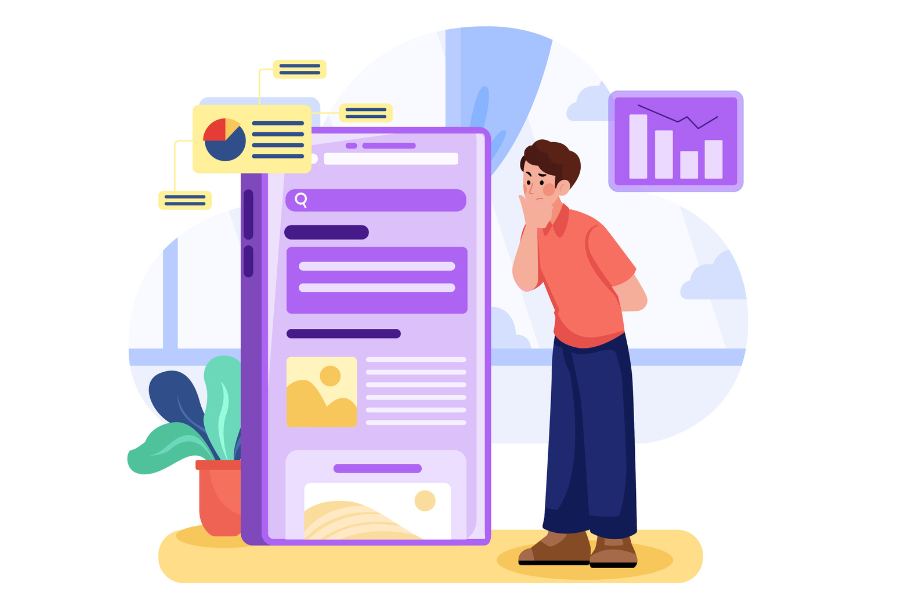Home / Functional Web Design / Web Design / A Comprehensive Guide to Responsive Web Design for Digital Marketers
Key Takeaways
- Responsive web design is essential for optimal user experience and search engine visibility for mobiles.
- Google prioritizes mobile-friendly websites, making responsive design crucial for higher search rankings and increased organic traffic.
- Maintaining a single responsive website is more cost-effective than managing separate versions for different devices.
- Fluid grids, flexible images, and CSS media queries are the key ingredients that enable websites to adapt seamlessly to various screen sizes.
- Adopting a mobile-first design approach ensures that websites cater to the majority of users who primarily access the internet through their smartphones.
Most people access websites using smartphones and tablets more than their computers. This means your website must look amazing on every device and offer the best possible user experience no matter what screen size someone uses.
Responsive web design is essential for websites. It allows your website to automatically adjust to any screen size, whether someone is viewing it on a large desktop monitor or a small smartphone screen. This ensures that text is readable, images are appropriately sized, and navigation is easy to use, leading to happy visitors and improved conversion rate optimization (CRO).
In this article, we’ll study the history of responsive design, its benefits, and some best practices. We’ll also explore how responsive design impacts SEO and user experience.
Mobile Responsive Web Design
The way we access the internet has fundamentally changed. Mobile devices have overtaken desktops, changing how we consume information and interact with businesses. We use our smartphones for everything; from checking email and social media to online shopping and banking. This shift towards mobile has desperately changed, and it changes how we approach responsive web design.

One of the biggest changes in recent years is mobile-first indexing. In simple terms, this means Google primarily uses the mobile version of your website to determine your ranking in search results. Why? Because most people are searching on their phones! So, if your website isn’t built with mobile-first design principles in mind, or doesn’t use responsive web design to adapt to smaller screens, you’re likely to lose out on valuable traffic and potential customers.
The implications of not having a responsive web design are clear for businesses. A website that’s not optimized for mobile can lead to:
- Lost Traffic – People will quickly abandon a website that’s difficult to use on their phone.
- Lower Engagement – Frustrated users are less likely to interact with your content or explore your site.
- Reduced Conversions – If people can’t easily find what they’re looking for or complete a purchase on their phone, you’ll lose sales.
- Damaged Brand Reputation – A poor mobile experience can negatively reflect on your brand, making you seem outdated or unprofessional.
We’ll learn more about how responsive web design can help you delight your mobile visitors and provide them with a smooth browsing experience by adhering to responsive design principles.
Understanding Responsive Web Design
Now that we’ve established the importance of catering to mobile users, let’s explore the principles behind responsive web design. It’s all about creating an active and optimized experience for every user, regardless of their device. By understanding the benefits of responsive design, you can discover your website’s success.

Key Ingredients That Make Responsive Web Design Work
Responsive web design is crucial for reaching your audience on any device, ensuring a positive user experience. To achieve this smooothness, several key ingredients must work together.
Fluid Grids
Responsive web design utilizes fluid grids that adapt to different screen sizes. This ensures that your content flows naturally and doesn’t get stuffed into a tiny space on smaller devices. Instead of fixed-width elements, fluid grids use percentages to define widths, allowing content to rearrange and resize itself harmoniously. This flexibility is fundamental for a comfortable viewing experience across all devices.
Flexible Images
Images are an essential part of any website, but they can be a major reason for slow loading times and poor mobile experiences. Responsive web design uses flexible images that scale proportionally to the screen size, ensuring they look sharp and load quickly on any device. This contributes to a positive user experience (UX), a key factor in responsive design principles.
CSS Media Queries
Media queries are like rules that tell the website how to display content based on the user’s device. They allow you to adjust font sizes, hide or show certain elements, and rearrange the layout to create an optimal viewing experience for different screen sizes. This technique is essential for achieving true cross-device compatibility.
While the terms are often used interchangeably, it’s important to distinguish between responsive web design and adaptive web design.
- Responsive design uses the same underlying codebase for all devices, with CSS media queries adjusting the layout and presentation. This is like a single recipe that can be tweaked to create different variations of a dish.
- Adaptive design, on the other hand, detects the user’s device and delivers a tailored version of the website specifically designed for that screen size. This is like having separate recipes for each dish.
Both approaches have their pros and cons, but responsive design is generally selected for its flexibility, cost-effectiveness, and SEO benefits.
A critical aspect of responsive web design is the mobile-first design approach. This means designing the website for mobile devices first and then advancing to larger screens. This ensures that the core content and functionality are prioritized for mobile users, who now make up the majority of web traffic.
By understanding these main principles, you can appreciate the complexity and creativity behind responsive web design and its impact on creating user-friendly websites.
Benefits of Responsive Web Design
By now, you understand that responsive web design is essential nowadays. But what exactly are the benefits of responsive design? Let’s explore how investing in a responsive website can positively impact your business and digital marketing efforts.

Improved User Experience
The responsive design principles goal is to provide an exceptional user experience (UX). A responsive web design ensures that your visitors have a positive and smooth experience, regardless of the device they’re using.
Let’s say you are trying to navigate a website on your phone where the text is tiny, the buttons are too close together, and the images take forever to load. This situation is very frustrating. Responsive web design eliminates these issues by:
- Optimizing content for different screen sizes – Text is easily readable, images are appropriately sized, and navigation is built-in, contributing to a smooth and enjoyable user experience.
- Ensuring fast loading times – No one likes to wait for a website to load, especially on mobile. Responsive websites are optimized for speed, keeping users engaged and reducing bounce rates, which is an essential aspect of responsive design best practices.
- Providing a consistent experience across devices – Whether someone is browsing on their desktop or smartphone, they’ll have the same positive experience on a responsive website, supporting cross-device compatibility.
A positive user experience leads to increased engagement, longer visit durations, and higher conversion rates, ultimately benefiting conversion rate optimization (CRO) efforts.
SEO Benefits
Responsive web design plays an important role in improving your website’s visibility in search results. Google prioritizes mobile-friendly websites, and responsive design is an essential factor in achieving that.
Here’s how responsive web design boosts your SEO:
- Improved mobile rankings – With mobile-first indexing, having a responsive web design is essential for ranking well in mobile search results.
- Increased crawl efficiency – Google’s bots can easily crawl and index responsive websites, as they only need to crawl one version of the site.
- Reduced duplicate content issues – With a single codebase, responsive web design avoids the duplicate content issues that can occur from having separate mobile and desktop versions.
- Improved backlink profile – A high-quality responsive website is more likely to attract backlinks from other websites, which further boosts your SEO.
Cost-Effectiveness
While there’s an initial investment involved in building a responsive website, it’s far more cost-effective in the long run compared to maintaining separate mobile and desktop versions. This streamlined approach simplifies updates and maintenance, as changes are made once and reflected across all devices.
With responsive web design, you only need to manage one website, which means:
- Lower development and maintenance costs – You save the time and resources required to develop and maintain multiple versions of your website.
- Simplified content management – Updating content is easier and faster, as you only need to make changes in one place.
- Reduced hosting costs – You only need to host one website, which can lower your hosting expenses.
Increased Reach and Accessibility
Responsive web design ensures that your website is accessible to a wider audience, regardless of their device or location. This extends your reach and allows you to connect with potential customers across different platforms. Ultimately, this inclusivity translates to increased traffic and potential conversions as users enjoy a seamless experience on your site.
Improved Brand Credibility
Your website is often the first impression potential customers have of your business. A professional and responsive website enhances your brand image and builds trust with your audience. By demonstrating adaptability and a commitment to user experience, you establish credibility and inspire confidence in your products or services.
A well-designed responsive web design shows that you care about your customers’ experience and are invested in providing them with a smooth and enjoyable online journey. This can lead to increased brand loyalty and advocacy.
Responsive Design Best Practices
Now that you understand the benefits of responsive design, it’s time to learn how to implement it effectively. Creating a responsive web design involves more than just making your website shrink on smaller screens.

Here are some responsive design best practices to guide you through the process:
Prioritize Mobile-First Design
As we’ve discussed, the mobile-first design approach is essential for success. Start by designing your website for mobile devices and then scale up for larger screens. This ensures that the core elements of your website are optimized for the most common device size and contribute to a positive user experience (UX).
Use a Responsive Framework
A responsive framework provides a foundation for building a responsive web design. Popular frameworks like Bootstrap, Foundation, and Materialize offer a range of tools and templates to make the process easier. These frameworks often incorporate fluid grids and flexible images to simplify the implementation of responsive design principles.
Optimize Images
Images can be a major issue for mobile performance. To ensure fast loading times, optimize your images by compressing them without sacrificing quality. Use appropriate file formats and dimensions, and include descriptive alt text for accessibility. This is a key aspect of responsive design best practices and contributes to better mobile optimization.
Create Touch-Friendly Navigation
Your navigation menu should be easy to use on mobile devices with touch-friendly navigation. Use a hamburger menu icon or a collapsible menu that displays submenus when tapped. Keep the menu items concise and clear, and avoid using complicated drop-down menus. This will enhance user experience and ensure smooth navigation on smaller screens.
Test Across Devices for Cross-Device Compatibility
It’s essential to test your website on different types of devices and browsers to ensure that it displays correctly and functions as intended, achieving true cross-device compatibility. Use tools like BrowserStack or Google Chrome’s Developer Tools to simulate different screen sizes and resolutions.
Monitor Performance
Keep an eye on your website’s performance using tools like Google Analytics. Track metrics like page load speed, bounce rate, and conversion rate to determine any areas for improvement. This will help you optimize your responsive web design for maximum effectiveness and conversion rate optimization (CRO).
Stay Up-to-Date with Responsive Design Trends
The world of web design is constantly growing, and responsive design best practices are no exception. Stay up-to-date on the latest trends and technologies to ensure that your website remains competitive.
By following these responsive design best practices, you can create a responsive web design that provides an exceptional experience for your users and drives positive results for your business.
Responsive Design Examples for Different Industries
Every business is different, and so are their website needs. Responsive web design can be adapted to fit any industry or type of business. Its implementation can differ greatly depending on the industry and the specific needs of a business.

Let’s explore some examples of how responsive design is used across different industries, with a focus on businesses in the Dallas area. By understanding how responsive design principles are applied in different contexts, you can gain a deeper appreciation for their versatility and impact.
1. E-commerce
For E-commerce, like a trendy clothing boutique with an online store. With responsive web design, their website can provide a smooth shopping experience whether customers are browsing new arrivals on their smartphones during their lunch break or adding items to their cart from their desktop at home. This is an excellent example of how responsive web design enhances user experience (UX) and drives conversion rate optimization (CRO).
Key features of a responsive web design for an e-commerce website:
- High-quality product images that scale beautifully on any device, showcasing the ability of flexible images.
- Easy-to-use filters and search functionality optimized for touchscreens, ensuring a smooth mobile experience.
- A streamlined checkout process that’s secure and mobile-friendly, crucial for maximizing conversions.
2. Healthcare
For a healthcare provider in Dallas, like a dental practice or a specialized clinic, a responsive web design is essential for providing patients with easy access to information. This is particularly important in the healthcare industry, where accessibility and user experience are paramount.
Key features of a responsive web design for a healthcare website:
- Clear and concise information about services, doctors, and locations, is easily accessible on any device.
- Easy-to-find contact information and appointment scheduling tools, optimized for both desktop and mobile users.
- Accessibility features for users with disabilities, ensuring everyone can access vital health information, a critical element of responsive design best practices.
3. Restaurants
Responsive web design, especially when combined with a mobile-first design approach, allows them to showcase their menus, ambiance, and online ordering options in a way that’s appealing and functional on all devices.
Key features of a responsive web design for a restaurant website:
- Delicious food photography that looks stunning on any screen, demonstrating the importance of flexible images.
- Easy-to-navigate menus with clear descriptions and pricing, optimized for different screen sizes.
- Main online ordering or reservation buttons optimized for mobile users, encouraging conversions.
- Location information and hours displayed, ensuring a positive user experience.
4. Legal Services
For law firms in Dallas, a professional and responsive web design can help build trust and credibility with potential clients. By ensuring cross-device compatibility and sticking to responsive design principles, law firms can reach a wider audience and provide a positive user experience.
Key features of a responsive web design for a legal website:
- Clear and concise information about the firm’s areas of expertise and attorneys, is easily accessible on any device.
- Easy-to-find contact information and consultation request forms, optimized for mobile users.
- A blog or resources section with informative articles on legal topics, demonstrating expertise and building trust.
By showcasing these various examples, we aim to illustrate the versatility and impact of responsive web design across various industries.
Adopt the Future of Web Design with Responsive Strategies
Responsive web design is important in every business’s website. From boosting your SEO and improving user experience to increasing conversions and enhancing your brand credibility, the benefits of responsive design are undeniable.

Throughout this article, we’ve examined the growth of responsive web design, jumped into its core principles, and highlighted its importance for businesses across various industries. By embracing responsive design best practices and prioritizing mobile-first design, you can ensure your website provides a smooth and engaging experience for every visitor, regardless of the device they’re using.
Partner with Experts to Drive Results with a Responsive Website
Bless Web Designs understands the importance of responsive web design for businesses of all sizes. We’ve helped numerous clients in Dallas create captivating and functional websites that adapt seamlessly to any device, showcasing the ability of adaptive web design techniques and mobile optimization strategies.
Maximize conversions with a responsive website from Bless Web Designs. Contact us today for a free consultation and let our expert team create an attractive and functional website that adapts smoothly to any device.


